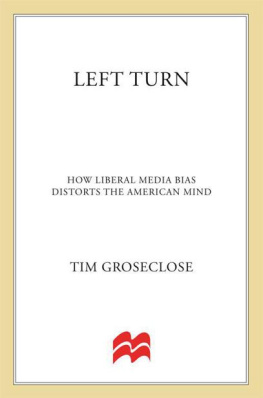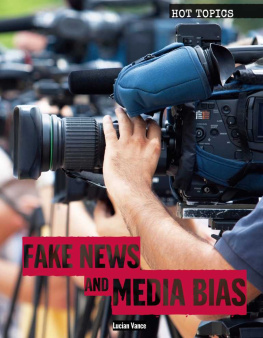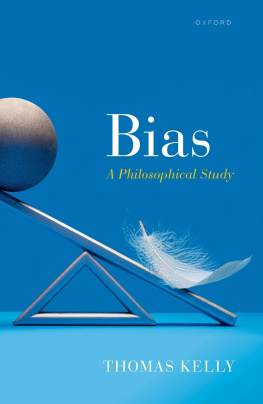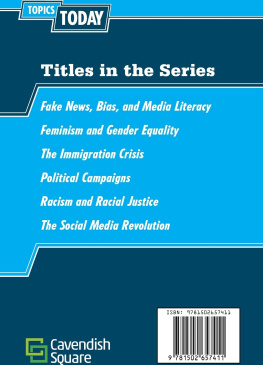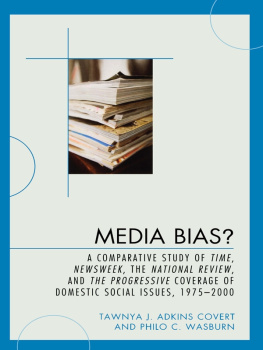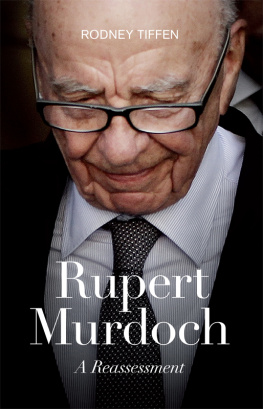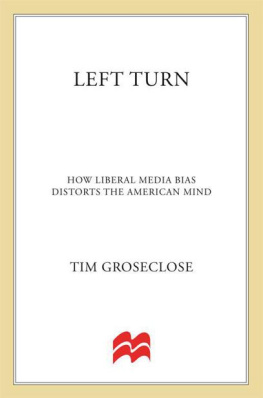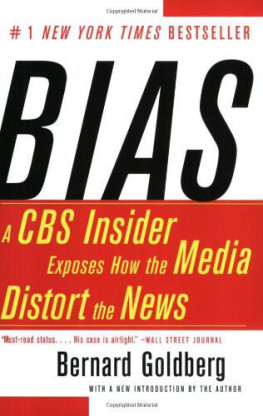CONTENTS
PREFACE
IN AT LEAST one important way journalists are very different from the rest of usthey are more liberal. For instance, according to surveys, in a typical presidential election Washington correspondents vote about 937 for the Democrat, while the rest of America votes about 5050.
What happens when our view of the world is filtered through the eyes, ears, and minds of such a liberal group?
As I demonstrate, using objective, social-scientific methods, the filtering prevents us from seeing the world as it actually is. Instead, we see only a distorted version of it. It is as if we see the world through a glassa glass that magnifies the facts that liberals want us to see and shrinks the facts that conservatives want us to see.
The metaphoric glass affects not just what we see, but how we think. That is, media bias really does make us more liberal.
Perhaps worst of all, media bias feeds on itself. That is, the bias makes us more liberal, which makes us less able to detect the bias, which allows the media to get away with more bias, which makes us even more liberal, and so on.
All of this means that the political views that we currently see in Americans are not their natural views. We see only an artificial, distorted version of those views.
Main Conclusions of the Book
In this book I calculate the precise degree to which those views have been distorted. Specifically, I answer the question: What if we could magically remove the metaphoric glass and see, face-to-face, the average American, once his political views were no longer distorted by media bias ? What would we see?
The answer, basically, is Ben Stein.
Yes, the actor, author, commentator, and former host of Win Ben Steins Money. More specifically, the person whom wed see would be anyonelike Ben Steinwho has a political quotient near 25. The political quotient is a device Ive constructed to measure political views in a precise, objective, and quantitative way. A persons PQ indicates the degree to which he is liberal. For instance, as I have calculated, the PQs of Barney Frank (D-Mass.) and Nancy Pelosi (D-Calif.) are approximately 100. Meanwhile, the PQs of Michele Bachmann (R-Minn.) and Jim DeMint (R-S.C.) are approximately 0.
Two other people whose PQs are approximately 25 are Bill OReilly and Dennis Miller. OReilly and Miller are significantly more conservative than the average American voter, whose PQ is approximately 50. But they are significantly more liberal than politicians such as Michele Bachmann or Jim DeMint.
As my results show, if we could magically eliminate media bias, then the average American would think and vote like Stein, Miller, OReilly, and others who have a PQ near 25.
In this magical worldcall it a Ben Stein-ocracythere would be just as many politicians to the left of Stein, OReilly, and Miller as there were to their right. The same thing would be true of policiesthat is, Stein, OReilly, and Miller would complain just as often that U.S. policies were too conservative as they would complain that they were too liberal.
In such a world, American political values would mirror those of present-day regions where the average voter has a 25 PQ. Such regions include the states of Kansas, Texas, and South Dakota. They also include Orange County, California, and Salt Lake County, Utah.
To the liberal elite, such places are a nightmare. They are family-friendly, largely suburban, and a large fraction of their residents go to church on Sundays. Ah, dont cross the Orange Curtain, I once heard a Hollywood acquaintance say to another Hollywood acquaintance, referring to a visit to Orange County.
In an episode of The Sopranos, Tony goes into a coma after being shot. He dreams that he is stuck in a hotel in Costa Mesa (a town in Orange County). He and the other guests of the hotel slowly realize that they are not free to leave. The hotel, many believe, was intended by The Sopranos writers to represent Purgatory.
To the liberal elite, thats the way the world would be if media bias were to disappearlike Orange County, not quite hell, but a step in that direction.
Construction of the Books Argument
To some people, these conclusions will sound shocking. However, they are supported by: (i) eight years of research; (ii) some state-of-the-art statistical and social-scientific methods; and (iii) recent, little-noticed, yet brilliant, research by some rising-star professors of economics and political science.
In addition, once you learn some not-so-shocking intermediate conclusions that I construct, the main conclusion might not seem so shocking. The following are some of those intermediate conclusions:
The PQ is based upon issues chosen by the Americans for Democratic Action, a liberal interest group. Thus, to demonstrate liberal media bias, I use a measuring rod, that is based on criteria selected by liberals.
Through the notion of a slant quotient, I show that media bias, like political views, can be measured objectively and quantitatively.
According to these slant quotients, every mainstream national news outlet in the United States has a liberal bias.
Of the one hundred or so news outlets I examine, only a handful lean to the right. These include: The Washington Times, The Daily Oklahoman, the Arizona Daily Star (Tucson), and Fox News Special Report.
But even these supposedly conservative news outlets are not far right . For instance, the conservative bias of Special Report is significantly less than the liberal bias of CBS Evening News, and it is approximately equal to the liberal bias of ABC World News Tonight or NBC Nightly News .
The effects of media bias are real and significant. My results suggest that media bias aids Democratic candidates by about 8 to 10 percentage points in a typical election. I find, for instance, that if media bias didnt exist, then John McCain would have defeated Barack Obama 5642, instead of losing 5346.
In our current world, where views are distorted by media bias, the PQ of the average voter is approximately 50. This is about the score of Sen. Ben Nelson (D-Neb.) or Sen. Olympia Snowe (R-Me.).
However, if we could magically eliminate media bias, then the PQ of the average voter would decrease to approximately 25 or 30.
In our current world, where views have been distorted toward the left, news outlets such as The Washington Times and Fox News Special Report seem conservative. However, if we could remove the left-wing bias of the media as a wholeand thus change the average voters PQ to 25 or 30then The Washington Times and Special Report would seem slightly left-leaning.
Introduction
DISCUSSIONS ABOUT MEDIA bias can really inflame peoples passions.
In the spring of 2002, I began a research project with Jeff Milyo, who at the time was a public policy professor at the University of Chicago. Our goal was to create a method that would objectively measure the bias of the media.
The motivation was simple. In social science we have lots of precise numerical devices that measure how liberal or conservative politicians are. There ought to be something similar for the media.
Three and half years later, after thousands of hours of gathering and analyzing data, we achieved that goal. For twenty major news outlets, we estimated a score, between 0 and 100, that described how liberal each outlet was. The beauty of the scores, which I now call slant quotients, is that they are directly comparable to political quotients. This means that they can answer questions such as: (i) Is The New York Times to the left or right of Hillary Clinton? or (ii) Is Fox News to the left or right of John McCain?
The results generally agreed with the claims of conservatives. For instance, our method found that eighteen of the twenty outlets were left of center. The only two that were not were The Washington Times and Fox News Special Report with Brit Hume.
Next page
